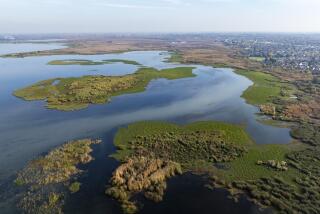California’s coast is disappearing, and the debate over what to do about it is in full swing

Even as quakes, wildfires and drought have taken up most of our focus, the slow-moving disaster of rising seas has paralyzed Californians, and left us with “both too much and not enough time” to act, as environment reporter Rosanna Xia wrote in a special report examining sea level rise and the future of California’s disappearing coastline.
The report, read by more than half a million people since it was published online and in print on Sunday, laid out our limited options in a future where certain areas of California will almost certainly be submerged.
The California coast is disappearing under the rising sea. Our choices are grim »
Cities such as San Francisco, Pacifica, Imperial Beach and many more are already dealing with the ocean at their doorstep. The Times even created a game to help readers understand the challenges that city officials, planners and residents face as the sea continues to move inland.
The Ocean Game: The sea is rising. Can you save your town? »
In a Q&A from Tuesday’s Essential California newsletter, Julia Wick had this question for Xia:
Wick: What does it take to effectively mobilize people to take action around a so-called slow-moving disaster?
Xia: That’s the challenge. That’s why we’re doing this story before the big disaster hits. I think that as a society we’re not really good at mobilizing before a disaster, only after. Think of Katrina, think of Superstorm Sandy. Think of the wildfires. What we really hope to achieve with this story is to lay out the stakes and the costs and the trade-offs ahead of time.
Essential California: How to react when the sea is rising »
The report incited strong reactions from Californians and residents of coastal communities across the U.S. Here’s what some of them had to say:
- Batcavern: Whether climate change or not (and I believe there is a human-induced climate change crisis), people who build along the coast get no sympathy from me. You take on Mother Nature and you always lose. Always. The ocean will reclaim the coastline and these fools should never have built there in the first place.
- Chantal17: Adding sand, it eventually disappears. Building the wall, the ocean can eventually overtake the wall, so it just buys time. Relocating homes is the long-term solution because the water is steadily getting closer. Homeowners who want to stay with a wall should pay for 30-50% of the wall length in front of their property. Taxpayers shouldn’t pay. Staying with no wall and wanting sand brought in is similar to “No lifeguard on duty.” It’s a high-risk situation. Never thought I’d hear about California shores eroding — sad. Not like I remember growing up.
- Joseph 9988: Engineering our way out of this pending crisis with sea walls is not the only solution. Using sand dunes planted in mangroves and other ocean vegetation will slow the impact of the water surge, but will also take away the open flat beaches and the look of California’s coastline. I am sure at one point our coastline had such natural barriers till we overdeveloped it. Now might be a good time to give a natural vegetation barrier the chance to protect the coastal cliffs and lower coastal communities.
- Nobland: That was one of the most concise and well-documented articles I’ve seen on the subject. Full of real-time, real-place effects. It doesn’t much matter if you sympathize with the coastal property owners and town managers. The coastal issue is merely one small example of what is coming our way. For my part, I have done the best as I can to prepare for my family’s future this century. Pulled out of California 25 years ago and now own 50 acres in Hawaii ... a great location to watch the world unwind. Good luck to us all. It is going to be a wild ride whether you are in California or Kansas. We only have this one planet and we’ve been messing it up.
- Brad Foley: It’s irresponsible to start an article on sea level rise with such an extreme premise as 9 feet sea rise by century’s end. Climate change is real, and it’s probably the biggest danger we face right now. But the IPCC high-end predictions are around 2 feet by the end of the century. This 9-feet number relies on a lot of worse-than-worst case scenarios.
Is the premise of nine feet of sea level rise really that extreme? That last reader comment was addressed during a Tuesday discussion on sea level rise hosted by Zócalo Public Square.
Moderated by Xia, the expert panel included:
- Effie Turnbull Sanders, a member of the California Coastal Commission
- Alex Hall, director of the UCLA Center for Climate Science
- Sean B. Hecht, co-executive director of the Emmett Institute on Climate Change and the Environment at the UCLA School of Law
Here are a few interesting takeaways from the discussion, which you can also watch on zocalopublicsquare.org.
Why are seas rising? Around 45% of sea level rise has occurred because the ice sheets and mountain glaciers are melting, Hall said. Another 45% is happening because the ocean has expanded as its waters have warmed. The final 10% comes from the drawdown of aquifers, such as taking water from the Central Valley of California to irrigate crops. That water eventually makes its way through streams and into the ocean.
More than 2 feet. We can anticipate 2 feet of sea level rise based on current projections, but those numbers may be too conservative, Hall said. There are signs the West Antarctic Ice Sheet (which is as large as a third of the U.S.) is becoming unstable from warming ocean waters underneath. If that ice sheet were to disintegrate, we’d have up to an additional 11 feet of sea level rise. It’s an unlikely worst case scenario, but not out of the realm of possibility.
Public trust and beaches. The public trust legal doctrine says that anything from where the wet sand meets the dry sand to the sea is held in trust for the public and cannot be owned, Hecht said. So as that line moves with sea level rise, a coastal homeowner’s property line would also move. The result is a conflict between private homeownership and public resources.
Coastal squeeze. With sea level rise comes coastal squeeze, in which habitat is lost as the sea forces beaches and dunes to migrate inward. The California Coastal Commission is focused on coastal squeeze, Turnbull Sanders said, particularly with protecting disappearing wetlands and giving cities guidance on how to make decisions around property as space vanishes.
Interested in learning more? The next Coastal Commission meeting, which is taking place Wednesday to Friday in San Luis Obispo, will devote a portion of time to discuss the issue of sea level rise in local jurisdictions beginning Friday at 11 a.m., according to the agenda.
The meeting with be livestreamed at coastal.ca.gov.
More to Read
Start your day right
Sign up for Essential California for news, features and recommendations from the L.A. Times and beyond in your inbox six days a week.
You may occasionally receive promotional content from the Los Angeles Times.







